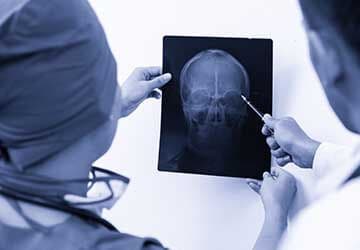Traumatic Brain Injury Lawsuits – What You Need to Know
A traumatic brain injury (TBI) – also known as acquired brain injury or head injury – is caused by a blow or jolt to the head or a penetrating head injury which disrupts the brain’s normal function and damages it. Traumatic brain injuries can occur when the head suddenly and violently hits an object, or when an object pierces the skull and enters brain tissue. TBIs may be the result of a car wreck, trucking accident, motorcycle accident, work accident, defective product, or dangerous condition on personal or business property.

TBI Symptoms
With severe brain injuries, the symptoms are more apparent. However, in the case of milder injuries, symptoms may not be present at the time of injury and may not appear for days or even weeks. Symptoms can be very subtle as well, causing the injured person, his or her family, and even doctors to miss them.
Common symptoms include:
- Headache
- Confusion
- Lightheadedness
- Dizziness
- Blurred vision or tired eyes
- Ringing in the ears
- Bad taste in the mouth
- Fatigue or lethargy
- Changes in sleep patterns
- Behavioral or mood changes
- Trouble with memory, concentration, attention or thinking
Moderate to Severe TBIs
A traumatic brain injury is classified as mild if the loss of consciousness and/or confusion and disorientation is shorter than 30 minutes. MRI and CAT scans are often normal. A person with a moderate or severe TBI may show these same symptoms, but may also have a headache that gets worse or does not go away, repeated vomiting or nausea, convulsions or seizures, an inability to awaken from sleep, dilation of one or both pupils of the eyes, slurred speech, weakness or numbness in the extremities, loss of coordination, and confusion, restlessness, or agitation.

Anyone with signs of moderate or severe TBI should receive medical attention as soon as possible. Little can be done to reverse the initial brain damage caused by trauma, so medical personnel try to stabilize an individual with TBI and focus on preventing further injury. Primary concerns include ensuring proper oxygen supply to the brain and the body, maintaining adequate blood flow, and controlling blood pressure.
Many people who are injured in car accidents can suffer from traumatic brain injury without it being immediately noticeable. You do not have to travel at a high rate of speed or hit your head on something like the steering wheel or windshield to suffer a brain injury. Even at moderate rates of speed, traumatic brain injuries can and do occur.
Mild TBIs
Mild traumatic brain injury is:
- The most prevalent form of TBI.
- Often missed at the time of initial injury.
- 15% of people with mild TBI have symptoms that last one year or more.
- Defined as the result of the forceful motion of the head or impact causing a brief change in mental status (confusion, disorientation or loss of memory) or loss of consciousness for less than 30 minutes.
- Post-injury symptoms are often referred to as a post-concussive syndrome.
Common symptoms of mild TBI include:
- Fatigue
- Headaches
- Visual disturbances
- Memory loss
- Poor attention/concentration
- Sleep disturbances
- Dizziness/loss of balance
- Irritability-emotional disturbances
- Feelings of depression
- Seizures
Traumatic Brain Injury Causes
When someone suffers a traumatic brain injury, three separate processes can work to injure the brain:
Bruising (Bleeding)
In the event of a blow to the head, or even a hard jolt (such as might happen in a car accident), a person’s brain is propelled against the hard bone of the skull, causing blood vessels to tear. When blood vessels tear, they release blood into areas of the brain. Because there is no room for extra blood inside the skull, the delicate brain tissue is compressed. If the pressure is too great and lasts too long, the tissue will stop working properly and may even die off.
In-car accidents, the force of a crash (or even stopping violently) can throw the soft tissue of the brain against the front part of the skull, causing bruising to the brain. Further injuries can occur as your body is thrown back against the seat – this is usually referred to as “whiplash.” When your body flies backward, so does the brain. After your brain bounces against the front of your skull, it is then propelled back to bounce against the back of the skull, causing bruising in different parts of the brain. Thus, people can have bruising not only where their heads may have hit the steering wheel or windshield or flew forward from braking, but in other areas of the brain as well. These injuries are often referred to as “contrecoup” injuries.
Tearing
This forward-backward jarring of the brain can also tear the brain tissue. This is very serious, as a tear in the tissue essentially “cuts the wires” that make the brain work. Tearing happens on a microscopic level and may not show up on typical medical tests, such as a CT scan or MRI.
Swelling
Like any other part of the body, the brain will swell in response to injury, as the body sends agents to heal the damaged area. However, there is no extra room inside the skull for the swelling. As with bruising/bleeding in the brain, the swelling will exert pressure on the sensitive brain tissues and damage them – sometimes permanently.
The CDC’s website states the severity of a TBI may range from “mild” – i.e., a brief change in mental status or consciousness – to “severe” – i.e., an extended period of unconsciousness or amnesia after the injury. The majority of TBI’s that occur each year are concussions and other minor TBIs.
Diagnosing a Traumatic Brain Injury (TBI)
Regardless of the severity of the injury, or if medical attention is sought immediately or later, imaging tests are critical to helping determine a specific diagnosis, prognosis, and treatment plan.
Skull and neck X-rays are common methods doctors employ to check for fractures and spinal instability. Various other scans help determine changes to both the structure and the function of the brain. Medical procedures that look at the structure of the brain are:
- CAT scan: The CAT scan uses X-rays to “slice” the brain radio-graphically into slabs. This method is particularly good at detecting fresh blood in and around the brain.
- MRI: Like the CAT scan, the MRI slices the brain into sections, but uses magnetic fields to do so. Though it is inferior to the CAT scan in its ability to detect fresh blood, the MRI is far better at locating old hemorrhaged blood, called hemosiderin. It also provides more detail than the CAT scan, showing brain damage as small as 1-2mm in size.
- Diffusion Tensor Imaging (DTI): This type of MRI uses special software to view parts of the brain a normal MRI cannot. This new technology images natural damage to the white matter. It is a very impressive technology and will be impressive to jurors and others involved in TBI litigation.
- MRA (Magnetic Resonance Angiography): This technology allows doctors to view the carotid and vertebral arterial systems in the neck and brain without having to inject contrast dye into the patient’s bloodstream.
There are several diagnostic imaging technologies available that provide information about damage to the brain’s function. These include:
- Electroencephalogram (EEG): Wires attached to the patient’s scalp act like antennae to record the brain’s electrical activity. Variations on normal electrical activity can provide insight into brain damage.
- Positron Emission Tomography (PET) Scan: The brain uses glucose for energy. By labeling a glucose molecule with a radioactive “tag,” then inhaling radioactive glucose and placing the patient’s head under a large Geiger counter, doctors can identify abnormal areas of the brain which are underutilizing glucose.
- Single Photon Emission Computed Tomography (SPECT) Scan: SPECT scanning is similar to PET scanning in that a radioactive chemical is administered intravenously to the patient, but the radioactive chemical remains in the bloodstream and does not enter the brain. As a result, the SPECT scan maps the brain’s vascular supply. Because damaged brain tissue normally shuts down its own blood supply, focal vascular defects on a SPECT scan are circumstantial evidence of brain damage.
- Magnetic Resonance Spectroscopy (MRS): This new tool, used in conjunction with MRI, detects the intra-cellular relationship of brain metabolites. While MRS is in its early stages, it holds great promise in the “objectification” of brain injury.
- Evoked Potentials: Each time a sensory system of the body – vision, hearing, touch – is stimulated, an electrical signal is generated in the brain. These electrical signals can be detected in Evoked Potential studies with electrical wires on the scalp, showing any deficits that could indicate brain damage.
- Lumbar Puncture: A lumbar puncture – also known as a spinal tap – is used to analyze cerebrospinal fluid. Analysis of the fluid can help tell doctors, for example, if there is any bleeding in the brain and spinal cord areas.
Long Term Effects of TBI
Though many TBI victims do not require hospitalization, according to CDC data, roughly half of patients with severe TBI will need surgery.
The treatment does not end in the hospital. Moderately to severely injured patients must undergo individually tailored rehabilitation, including physical therapy, occupational therapy, speech/language therapy, physical medicine, psychology/psychiatry, and social support. Patients suffering from moderate to severe brain injury can struggle long-term with multiple disabilities, including but not limited to:
- Cognitive deficits, such as confusion, impulsiveness, memory loss and difficulty maintaining concentration
- Speech/language deficits, including difficulty understanding the spoken word, difficulty speaking, slurred speech and difficulty reading and/or writing
- Difficulties interpreting sensory input, such as touch, temperature or limb position
- Partial or total vision loss, blurred vision or other vision-related problems
- Ringing in the ears, hearing loss or increased sensitivity to sounds
- Loss or diminished sense of smell or taste
- Chronic pain
- Sleep disorders
- Appetite changes
- Depression
- Aggression
- Dependent behaviors
TBI can also cause epilepsy and increase the risk for such conditions as Alzheimer’s disease, Parkinson’s disease, and other brain disorders that become more prevalent with age. Very severe TBI can leave the patient in a coma or vegetative state, requiring years of nursing home care.
TBI Statistics – You Are Not Alone
According to the Centers for Disease Control and Prevention (CDC), recent data shows that, on average, approximately 1.7 million people sustain a traumatic brain injury annually.
Each year:
- 230,000 Americans are hospitalized (longer than ER booking) as a result of TBI.
- 80,000 Americans experience the onset of long-term disability as a result of sustaining a TBI.
- More than 50,000 people die every year as a result of TBI.
Many people do not realize that traumatic brain injuries are prevalent. Oftentimes you or someone you love may have had a brain injury, and not know about it. Physicians often have difficulty diagnosing these types of injuries.
For example, many of the early studies that took place from 1935-1981 required one or more of the following:
- loss of consciousness;
- hospital admission; and/or
- positive neuro-radiological findings.
Corroboration for modern studies from the most recent data at the Center for Disease Control and Injury Prevention (CDC) states that there are 5.3 million children and adults living with the consequences of a traumatic brain injury across the nation. This number is approximately 2% of the U.S. population.
Traumatic brain injuries can happen to a child or adult of any age; however, the risk of TBI is highest among adolescents, young adults, and persons over the age of 75.
Examples of other prevalence rates (from CDC) follow:
- 400,000 with Spinal Cord Injuries
- 500,000 with Cerebral Palsy
- 2.3 million with Epilepsy
- 3.0 million with Stroke disabilities
- 4.0 million with Alzheimer’s Disease
- 5.3 million with TRAUMATIC BRAIN INJURIES
- 5.4 million with Persistent Mental Illness
- and 7.2 million with Mental Retardation
Vehicle crashes account for 40% of all brain injuries and are the most common cause of TBI. Falls are the second leading cause.
Call Today for Your Free Traumatic Brain Injury Lawsuit Consultation
People who suffer from traumatic brain injury need experienced legal representation if a case is going to be pursued. Brain injury litigation is very complex and unique. It requires brain injury attorneys who are experienced and familiar with the medical and legal issues involved.
If you believe that you or a loved one suffered a traumatic brain injury or wrongful death resulting from a TBI due to another person’s or business’s negligence, please call us today at 803.252.4800. Consultations are free and confidential. We can discuss the details of your case over the phone or schedule a face-to-face meeting with a traumatic brain injury attorney at our Columbia, SC office.


















